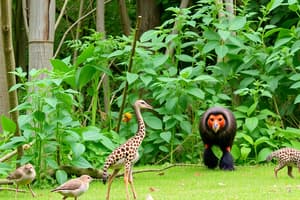Podcast
Questions and Answers
What term describes the total number of species in a community?
What term describes the total number of species in a community?
- Species distribution
- Species evenness
- Species abundance
- Species richness (correct)
In the context of competition, which type of competition is generally more intense within the same species?
In the context of competition, which type of competition is generally more intense within the same species?
- Intraspecific competition (correct)
- Interpersonal competition
- Predator-mediated competition
- Interspecific competition
Which example illustrates mutualism in nature?
Which example illustrates mutualism in nature?
- Brown and green anoles competing for insects
- Corals fighting for space on the reef
- Dominant plant species overshadowing others
- Clownfish providing protection to sea anemone (correct)
What is the significance of predator-mediated species coexistence?
What is the significance of predator-mediated species coexistence?
Species evenness relates to which of the following?
Species evenness relates to which of the following?
What is the primary focus of community ecology?
What is the primary focus of community ecology?
Which term describes a group of populations of different species living close enough to interact?
Which term describes a group of populations of different species living close enough to interact?
What type of species interaction is characterized by one species benefiting while the other is harmed?
What type of species interaction is characterized by one species benefiting while the other is harmed?
Which of the following interactions is considered beneficial for both species involved?
Which of the following interactions is considered beneficial for both species involved?
What concept describes the role of a species within its ecosystem, including its habitat and interactions?
What concept describes the role of a species within its ecosystem, including its habitat and interactions?
What differentiates a fundamental niche from a realized niche?
What differentiates a fundamental niche from a realized niche?
What is species diversity measured by?
What is species diversity measured by?
Which type of species interaction has a positive effect on one species and no effect on another?
Which type of species interaction has a positive effect on one species and no effect on another?
What is the primary reason in a population with logistic growth that dN/dt declines over time?
What is the primary reason in a population with logistic growth that dN/dt declines over time?
Which principle states that two species cannot coexist indefinitely on the same limiting resource?
Which principle states that two species cannot coexist indefinitely on the same limiting resource?
In terms of niches, what differentiates the fundamental niche from the realized niche?
In terms of niches, what differentiates the fundamental niche from the realized niche?
What is resource partitioning?
What is resource partitioning?
Which of the following factors are considered limiting resources for populations?
Which of the following factors are considered limiting resources for populations?
Character displacement refers to which of the following?
Character displacement refers to which of the following?
What outcome is suggested by Gause's experiments on species coexistence?
What outcome is suggested by Gause's experiments on species coexistence?
Which of the following best defines a niche?
Which of the following best defines a niche?
Flashcards
Community Ecology
Community Ecology
The study of how different species interact and live together within a specific area.
Ecological Community
Ecological Community
A group of different populations of species that live in a given area and interact.
Species Interactions
Species Interactions
How different species living together affect each other.
Competition
Competition
Signup and view all the flashcards
Competitive Exclusion
Competitive Exclusion
Signup and view all the flashcards
Niche
Niche
Signup and view all the flashcards
Fundamental Niche
Fundamental Niche
Signup and view all the flashcards
Species Diversity
Species Diversity
Signup and view all the flashcards
Species coexistence
Species coexistence
Signup and view all the flashcards
Intraspecific competition
Intraspecific competition
Signup and view all the flashcards
Interspecific competition
Interspecific competition
Signup and view all the flashcards
Mutualism (+/+)
Mutualism (+/+)
Signup and view all the flashcards
Limiting Resource
Limiting Resource
Signup and view all the flashcards
Competitive Exclusion Principle (Gause's Principle)
Competitive Exclusion Principle (Gause's Principle)
Signup and view all the flashcards
Realized Niche
Realized Niche
Signup and view all the flashcards
Resource Partitioning
Resource Partitioning
Signup and view all the flashcards
Study Notes
Community Ecology I
- Community ecology studies the distribution and abundance of coexisting species and their interactions.
- A biological community is a group of different species populations living close enough to interact.
- Plants, animals, and microbes are connected through interactions like predation, competition, and mutualism.
- Communities are often defined by their dominant life form and spatial characteristics.
Types of Interactions
- Mutualism (+/+): Both species benefit.
- Predation (+/-): One species benefits (predator), while the other is harmed (prey).
- Parasitism (+/-): One species benefits (parasite), while the other is harmed (host).
- Herbivory (+/-): An animal (herbivore) consumes a plant (herb).
- Competition (-/-): Individuals of both species are harmed as they compete for limited resources. Interspecific (between species) or intraspecific (within the species).
- Commensalism (+/0): One species benefits, while the other is neither harmed nor helped.
- Amensalism (-/0): One species is harmed, while the other is neither harmed nor helped.
What is a Niche?
- A niche is the set of all requirements of a species regarding resources and physical conditions.
- A niche can be represented by axes such as foraging height, light level, and food size.
Niche Concept
- Fundamental niche: The niche an organism would occupy in the absence of other species.
- Realized niche: The niche an organism occupies in the presence of other species.
- Competition and presence of other species may cause the realized niche to be smaller or differ from the fundamental niche.
Gause's Principle
- Competitive Exclusion Principle: Two species cannot coexist indefinitely on the same limiting resource (Gause 1934).
- Species cannot occupy the same niche.
Species Coexistence
- Coexistence of species is the norm.
- Resource partitioning: Species minimize competition by using resources in slightly different ways or at different times.
- Character displacement: Competition can drive the evolution of traits like beak size in species.
- Predator-mediated coexistence: A weaker competitor may persist in the presence of a stronger competitor due to a predator targeting the stronger competitor.
- Facilitated coexistence: Species may cohabit in the same environment using the same resources. However, they occupy different areas within that environment.
Species Diversity
- Species richness: Total number of species in a community.
- Species evenness: Relative abundance of each species.
- Higher diversity means more species, and they are relatively abundant.
Mutualisms
- Mutualisms are considered "biological markets," involving nutritional exchange, protection, or transport.
- Examples include corals and clownfish, mycorrhizae, ant-plant relationships, pollination, and seed dispersal.
Studying That Suits You
Use AI to generate personalized quizzes and flashcards to suit your learning preferences.




